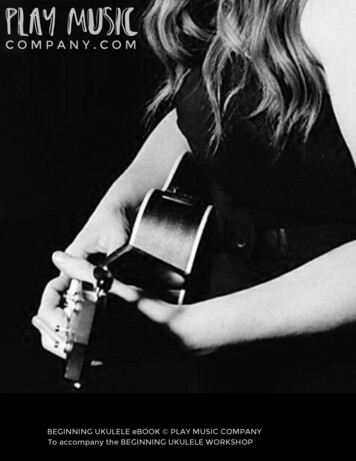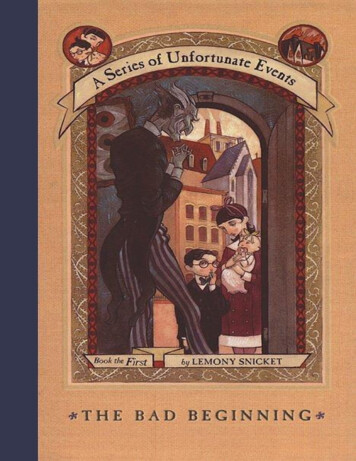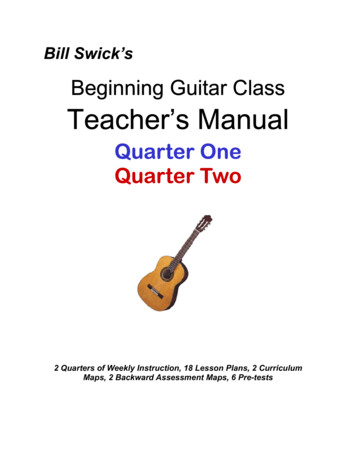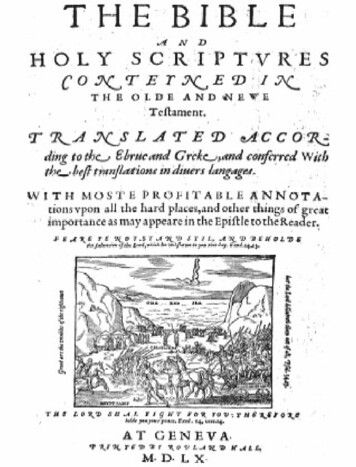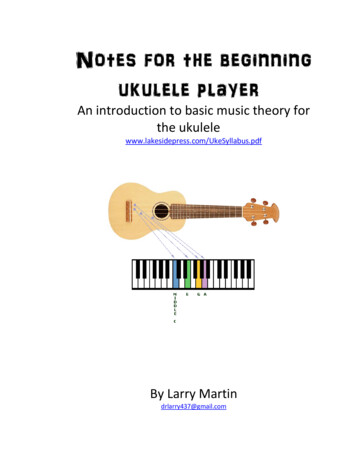
Transcription
Notes for the beginningukulele playerAn introduction to basic music theory forthe ukulelewww.lakesidepress.com/UkeSyllabus.pdfBy Larry Martindrlarry437@gmail.com
Notes for the beginningukulele playerAn introduction to basic music theory for theukulelewww.lakesidepress.com/UkeSyllabus.pdfBy Larry Martindrlarry437@gmail.comFirst placed online June 27, 2016Last revision September 25, keside PressThe Villages, FL 32163
First, Take the Uke Quiz 1.The notes of the F chord, as shown below on the fret board (reading left to right), are:a)b)c)d)2.If you score 16 or better in this 20-question quiz (without looking up theanswers), you are fairly knowledgeable about uke music theory. You can usethe Syllabus as a refresher, and perhaps pick up a few new things.If the information asked in these questions simply doesn’t hold any interest,then this Syllabus is not for you.If, however, you have a moderate to low score and you find the questionsinteresting, then you should benefit from the Syllabus.Finally, if you don’t like quizzes, or find them intimidating, but want to learnbasic music theory, then skip to the Preface. (And if Prefaces bore you, skipthat and go right to the Table of Contents, page 9).G-C-F-AA-C-F-AG-C-F#-AG#-C-F-AThe notes of the G chord as shown below on the fret board (reading left to right), are:a)b)c)d)G-D-G-BG-D-F#-BbG-D-G-BbG-D#-G-Bb1
3. The IV-V-I chord progression in the key of A is:a)b)c)d)4.A-D-GD-E-AD-F-AA-D-AThe fret board is standard-tuned to G-C-E-A. What note would be played by pressingthe first red dot (closest to nut) and picking that string higher up the fret board?AECGa)b)c)d)5.AbGG#AThe notes played picking each string (starting with the G string) when the first fret isbarred (shown by blue line) are:AECGa)b)c)d)G–C–E–AA – D – F – A#G# - C# - F – A#G# - D – F - B6. The notes played picking each string above the 4th fret bar (blue line), starting with the Gstring), are:2
a)b)c)d)7.The notes on this piano keyboard represent which chord diagram?a)8.B–E–G-CB – E – G# - C#C–F–A–DA# - D# - G – Cb)c)d)The notes on this piano keyboard represent which chord diagram?3
a)b)c)d)9. In playing a movable chord, what is the minimum number of strings that must bepressed?a) 1b) 2c) 3d) 410. Below is the G chord, played with fingers 1, 3, 2. You can go from here to the Em chordby using your fourth finger to press:a)b)c)d)G string, 1st fretC string, 3rd fretA string, 3rd fretC string, 4th fret11. If you strum all the strings open in a standard tune ukulele (G-C-E-A), you will playwhich two chords?a)b)c)d)C6 and Am7CMaj7 and Am7A7 and C7A and CMaj74
12. The calypso strumming pattern is:a)b)c)d) None of these, as the calypso strum is used in 3/4 time songs.13. The following ukulele tablature is from the song Clementine. The notes of the first twomeasures are:AECGa)b)c)d)F–F–F–C–A–AG – G – G – F – A# – A#F# – F# – F# – C# – A – AE–E–E–D–A–A5
14. Starting with the G string (leftmost in the diagram), what chord is played by tablature0-2-1-2?a)b)c)d)15. Starting with the G string (leftmost in the diagram), what chord is played by tablature0-2-3-2?a)b)c)d)The following 5 questions are True - False.16. One F# immediately following the treble clef sign (as shown) signifies key of D.17. The lowest note you can play on the uke turned to G-C-E-A, with are-entrant G string, is middle C.18. The Hawaiian D7 chord does not contain the D note.19. E7 can be substituted for E in the key of A20. The I-IV-V chord progression in key of F is F-B-C.Answers at end of Preface6
PrefaceThe ukulele is not easy but is easier than most other instruments for an adult to learn– compared, say, to the dulcimer, guitar, piano or any wind instrument. It also hasadvantages over three flute-like instruments adults are often drawn to as beginninginstruments -- the recorder, the Native American flute, and the pennywhistle. Those windinstruments are not designed to play chords, just the melody line, so they are morelimited than the uke, which can do both.For beginners, one of the best things about the ukulele is that most uke clubs are verywelcoming. In a typical club session no one can hear you (except perhaps the personsitting next to you). If you joined any other instrument group – playing flute, horn, guitaror dulcimer, for example – with the same level of inexperience, you would be outedinstantly. The uke is forgiving because it doesn’t carry far and in a jam session goodplayers or singers usually provide the rhythm and melody. In many sessions where I havefumbled on chord changes or lost the strum pattern, no one has ever noticed (as far as Iam aware).The downside of this easy acceptability is that most people who play in a uke groupget by with just strumming along, so there’s little incentive to learn about the makeup ofindividual chords, what notes are generated by the finger patterns, or why certain chordsare played in some songs and not others. People just come to play and have fun. Whichmakes sense -- the club is not a classroom.Still for the non-musician, the more you understand how the ukulele works, thebetter player you are likely to become. This idea is stated clearly by professional playerBrett McQueen, creator of one of the top uke web sites, ukuleletricks.com:Why You Should Know This StuffBrett McQueenI’ve said it before. You can get by without knowing a whole lot of theory, but theory helpsyou to articulate in your mind what you’re actually playing. It’s a language that allows youas a musician and artist to communicate the things you want to communicate.This syllabus is by a novice who became interested in how the ukulele works, andnow wants to teach other beginners. In that sense the Syllabus has a unique perspective. Ithelps that I know what we don’t know. Before playing the uke I had no musicalknowledge and played no other instrument. I am far from what anyone would call a“musician.” I am not a music teacher, but prefer to consider myself a “music explainer.”If you play the uke, and have any interest in how the instrument “works” to make music,you should find this syllabus helpful. It is also chock full of links to internet videos andother sources to enhance your understanding.To produce this syllabus I have freely used images from the internet. These imagesare copyrighted by the original creators. Thus this work cannot be used for anycommercial purpose, and should be viewed as a free teaching aid. At the same time,anyone should feel free to use my text for their own purposes.7
To get the most out of this syllabus you should have a uke tuned to G-C-E-A, a tuner(shown below, attached to the uke’s head), know at least a few basic chords, and havesome experience playing in a group setting (even if only a few times).In each section are short quizzes to help you review the material. Look for the yellowheadings QUIZ TIME. I strongly recommend you do each Quiz before proceeding to thenext section. Answers are provided after Section 10. Also included are several appendiceswith additional material. Some of this material is truly beyond beginner level, but isincluded to show how much more there is to learn about this amazing instrument.Larry Martindrlarry437@gmail.comAnswers to “First, Take the Uke 8.19.20.babdcbbdddabadcFalse; it is key of GTrueTrueTrueFalse; it is F-Bb-C8
TABLE OF CONTENTS (CLICK ON ANY SECTION OR APPENDIX)SECTION 1: NOTES OF THE UKULELE . 10SECTION 2: MUSICAL KEYS AND CHORD PROGRESSIONS . 16SECTION 3: THE UKE FRET BOARD . 26SECTION 4: COMMON CHORDS AND CHORD SUBSTITUTIONS. 30SECTION 5: LEAD AND SONG SHEETS, AND CHORDS . 32SECTION 6: CHORD VEXATION AND MOVABLE CHORDS . 38SECTION 7. CHORD TRICKS . 43SECTION 8: STRUMMING . 50SECTION 9: PLAYING MELODY ON THE UKULELE . 56SECTION 10 – ANATOMY OF UKULELE SHEET MUSIC . 67QUIZ TIME . 71ANSWERS TO QUIZ TIME. 72WEB SITE RECOMMENDATIONS . 74APPENDIX A: UKULELE SIZES, TUNINGS AND PARTS . 75APPENDIX B: THE C MAJOR SCALE . 79APPENDIX C: THE UKE FRET BOARD IN BOTH SHARPS & FLATS . 87APPENDIX D: BASIC CHORDS FOR THE UKULELE – FROM 6 DIFFERENT WEB SITES . 88APPENDIX E: AUGMENTED AND DIMINISHED CHORDS . 89APPENDIX F: SUSPENDED CHORDS . 99APPENDIX G: HOW TO USE THE UKULELE CAPO – BASIC THEORY . 105APPENDIX H: RANGE OF THE UKULELE AND THE LOW G STRING . 108APPENDIX I: BEYOND THE BASICS: CHUNKING, HAMMER-ON & OTHER TECHNIQUES . 114APPENDIX J: FINGERPICKING . 122APPENDIX K: 12-BAR BLUES . 1359
SECTION 1: NOTES OF THE UKULELEThe best way to understand your uke and the notes it can play is by reference to the pianokeyboard. Throughout this syllabus I show sections of the keyboard as they relate to theuke. You will get the most out of the syllabus if you can experiment on a keyboard – anykeyboard. If you have ready access to a keyboard or piano, great. If not, I recommendgoing online for a free piano simulator, at http://virtualpiano.net/. (If you prefer someother simulated online keyboard, that’s fine.)C25 E29G32 A34When you press a note on this simulated keyboard using your mouse or trackpad pointer,the name of the note shows at top, as in this figure from the simulator web site. Thenumbers you see when each key is pressed only refer to the keys of this particularsimulator; the notes of the ukulele tuned to G-C-E-A would be G-32, C-25, E-29 and A34.Musical ScalesAll music is based on musical scales, the easiest and most common of which is the Cmajor scale. The C major scale is played on the piano with just the white keys, as shownbelow. The C scale is C-D-E-F-G-A-B. To these 7 notes of the scale is usually included arepeat of the first note, which is then number 8.10
You can form a scale starting with any note of the keyboard. There are specific patternsto these scales. Some are major scales (one pattern), some are minor scales (anotherpattern). How the scales are formed is not important for our purposes. You just need toknow that each scale has a different arrangement of notes, in a specific order. Of themajor scales, only C major uses just the white keys on the piano. The other major scalesuse one or more black keys.Note that each black key is labeled with both a sharp (#) and a flat (b). What to call aspecific black key (sharp or flat) depends on the scale you’re in, and is not important forukulele players. Thus you can call the black key between C and D a C# or a Db; doesn’tmatter. (If you are composing music it does matter.)To repeat, the C major scale (including a repeat of the C) is:C-D-E-F-G-A–B-CBetween the eight keys of the C major scale are five more keys, all black keys. Here theyare labeled as sharps. These black keys are NOT part of the C major scale.C - C# - D - D# - E - F - F# - G - G# - A- A# - B - CI’ll show one more scale, the G major scale, and then get to the ukulele. The G majorscale includes one sharp, the F#. Here are the 8 notes of the G major scale, including arepeat of the G.G - A - B - C - D - E - F# - GNotes on the ukuleleIt’s easy to visualize the notes on the keyboard, where the sharps and flats are all blackkeys. If you go to your keyboard and alternate playing the white and black notes, you canappreciate the differences in the way they sound.11
The notes you “see” on the piano are also on your uke fret board; they are just not asobvious. To visualize the notes on the fret board let’s first look at the four strings of theukulele and relate them to the piano keyboard.Middle C is the lowest note you can play with the standard-tuned uke, which is G-C-E-A.In terms of pitch, going from lowest to highest, the notes are C-E-G-A. However, interms of order of strings, we call the tuning G-C-E-A. Picking these four strings insuccession (G-
The ukulele is not easy but is easier than most other instruments for an adult to learn – compared, say, to the dulcimer, guitar, piano or any wind instrument. It also has

